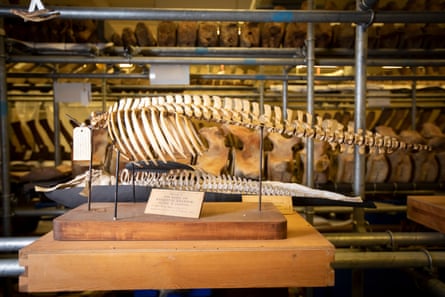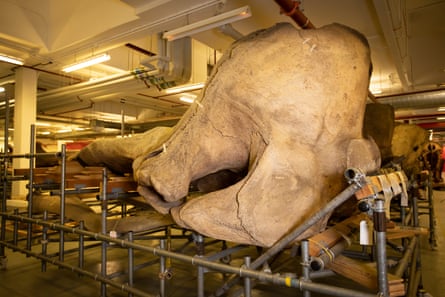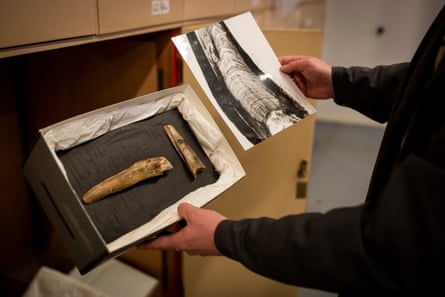The Daily Observer London Desk: Reporter- Sarah Marshal
Behind a 10-foot tall door, in a secret location, lies a treasure trove of bones. Some of the biggest bones are laid out on storage units made of scaffolding, others are stacked against each other on racks – rows and rows of specimens. The smallest are tucked into drawers of faded-yellow metal cabinets. A selection of skulls lies on a low table; crudely stuffed animals hang from the painted breezeblock walls. Everything is carefully labelled.
This vast room houses the Natural History Museum’s cetacean collection – a globally unique hoard of 6,000 whales, dolphins and porpoises. The artefacts are so enormous and irreplaceable, they’re housed at a secret location away from the main museum building.



It is the most complete collection of these creatures in the world, containing specimens of 90% of the world’s 90 cetacean species, including 24 from UK waters.
“It’s visually stunning, yes, but also incredibly scientifically and culturally significant,” says Richard Sabin, the Natural History Museum’s principal curator of mammals. “You’re looking at one of the best research collections of its kind in the world – what makes it unique is the species representation.”
The room’s cool temperature and low humidity have been designed to preserve its precious contents, from bones to baleen. As well as specialist biology and evolutionary history, the collection enables scientists to look at how everything from DNA to hormones vary across time and space.

Crucially, collections such as this (one of only five of its kind in the world), may provide clues about how whales, dolphins and porpoises might respond to future stresses such as the climate crisis. “These institutions are like reservoirs of scientific information,” Sabin says. “[Not only can we] look back in time and see how things have changed, we can plan for the future. That’s one of the greatest uses for this collection.”
The Natural History Museum has been officially recording whale and dolphin strandings since 1913, and many remains end up here after postmortem. In addition to 800 strandings, there are remnants from whaling expeditions and archaeological finds, some stretching as far back as 500 years.
One of the largest occupies a big glass cabinet, which dominates the main gangway. Here, the Thames whale lies in state: the northern bottlenose whale that became something of a celebrity in 2006 when it swam upriver, stranded on the sand in front of crowds of Londoners, and despite efforts to save it, died.

Another was uncovered in 2010 as builders dug new jetty foundations at Greenwich, in London. Huge bones sticking up out of the muddy Thames foreshore were identified by Sabin as a headless North Atlantic right whale. “The skeleton was at right angles to the flow of the river, with the tail facing up the slope of the beach … that’s not a natural stranding position,” he says. It had likely been pulled up by the tail, then beheaded for its precious baleen, once used to make corsetry and other garments.
Carbon dating pinpointed the Greenwich whale’s death to between 1580 and 1660, while cut marks on the bone surfaces indicated “defleshing”. “Everyone took what they could from it before the skeleton collapsed under its own weight,” says Sabin. “This animal is now the largest, oldest dated specimen of this species anywhere in the world – this skeleton can tell us a lot.” For example, its DNA could reveal whether limited genetic diversity, climate or competition contributed to right whales’ vulnerability before commercial whaling.
Elsewhere, dozens of jaw bones are stacked up. One lower jaw of a male sperm whale is abnormally twisted into a corkscrew shape: this unusual specimen came from an Antarctic whaling ship in 1959. At first glance, the jaw seems to make feeding an impossibility. But the back teeth, worn down to “stumpy pegs”, indicate that this whale was successfully eating giant squid, thanks to its highly specialised echolocation and efficient suction feeding.

Sabin, still fascinated by each revelation after 30 years as curator, is particularly proud of the insight garnered from crates containing 800 baleen plates from a blue whale stranded in 1891. Nicknamed Hope, the young female died on a sandbank near Wexford, Ireland. Now, her 25m-long skeleton is on display in the museum’s Hintze Hall.
By analysing her baleen – layers of keratin that are used to trap krill – scientists at Southampton University learned, using a technique known as stable isotope analysis, that in summer she fed near Norway, Iceland and Greenland to accumulate her fatty blubber layer, then in winter migrated south to the Azores and west Africa for the breeding season.


What’s more, visible ridges on this hard, black baleen represent the annual peaks and troughs of her feeding cycle, and scientists found that about 18 months before she died she remained in the south for 10 months – probably to have a calf. In the Wexford archives, Sabin found that violent storms were recorded in the days before she beached, storms that could have steered her off course.
In addition, researchers at Baylor University in Texas analysed her earwax and found her pregnancy hormone progesterone levels were elevated during the last 18 months of her life for 10 months – the blue whale gestation period. “Suddenly we have this rich information about the life of an individual whale that was living in 1890,” Sabin says.

With Sabin’s help, the same Texas team studied persistent chemical pollutants and the stress hormone cortisol in plugs of whale earwax to reveal how, between 1870 and 2016, human activities from commercial whaling, war, industrial pollution and shipping noise, have caused physical stress responses in whales.
“This information is written into the tissues of these animals,” Sabin says. “Suddenly, in the past 20 years, we’ve developed technologies that mean we can liberate information from this kind of material. We can take single hairs and do genome DNA testing or stable isotope analysis, which gives info about diet, distribution, movement, indicators.”

The museum is entering an era of digitisation, uploading 3D surface scans or CT scans of specimens to a free online database. It allows researchers anywhere in the world to collaborate. “This collection gives these specimens a life after death,” says Sabin. “What are we going to learn in the future?”



